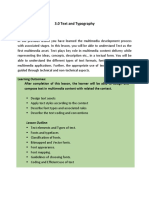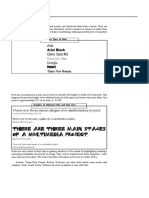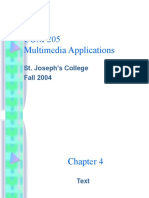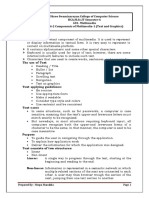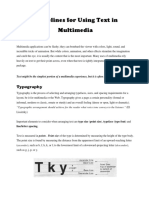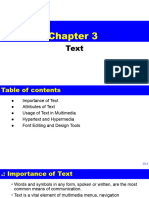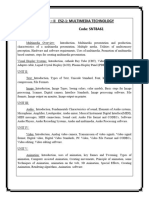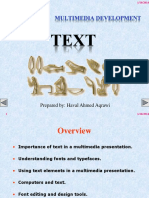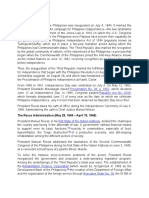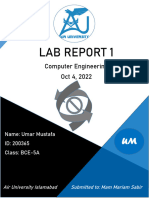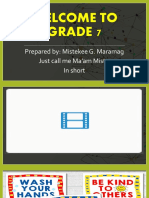Building Blocks
Uploaded by
Shreya SahniBuilding Blocks
Uploaded by
Shreya SahniText
2.1 Introduction
All multimedia content consists of texts in some form. Even a menu text is accompanied by a single action such as mouse click, keystroke or finger pressed in the monitor (in case of a touch screen). The text in the multimedia is used to communicate information to the user. Proper use of text and ords in multimedia presentation ill help the content developer to communicate the idea and message to the user.
2.2 Multimedia Building Blocks
Any multimedia application consists any or all of the follo ing components! ". Text: Text and symbols are very important for communication in any medium. #ith the recent explosion of the $nternet and #orld #ide #eb, text has become more the important than ever. #eb is %T&' (%yper text &arkup language) originally designed to display simple text documents on computer screens, ith occasional graphic images thro n in as illustrations. (. Audio: )ound is perhaps the most element of multimedia. $t can provide the listening pleasure of music, the startling accent of special effects or the ambience of a mood*setting background. +. Images: $mages hether represented analog or digital plays a vital role in a multimedia. $t is expressed in the form of still picture, painting or a photograph taken through a digital camera. ,. Animation: Animation is the rapid display of a se-uence of images of (*. art ork or model positions in order to create an illusion of movement. $t is an optical illusion of motion due to the phenomenon of persistence of vision, and can be created and demonstrated in a number of ays. /. Video: .igital video has supplanted analog video as the method of choice for making video for multimedia use. 0ideo in multimedia are used to portray real time moving pictures in a multimedia pro1ect.
2.3 Text in Multimedia
#ords and symbols in any form, spoken or ritten, are the most common system of communication. They deliver the most idely understood meaning to the greatest number of people. &ost academic related text such as 1ournals, e*maga2ines are available in the #eb 3ro ser readable form.
2.4 About Fonts and Faces
A typeface is family of graphic characters that usually includes many type si2es and styles. A font is a collection of characters of a single si2e and style belonging to a particular typeface family. Typical font styles are bold face and italic. 4ther style attributes such as underlining and outlining of characters, may be added at the users choice. The si2e of a text is usually measured in points. 4ne point is approximately "56( of an inch i.e. 7.7"+8. The si2e of a font does not exactly describe the height or idth of its characters. This is because the x*height (the height of lo er case character x) of t o fonts may differ. Typefaces of fonts can be described in many ays, but the most common characteri2ation of a typeface is seri and sans seri . The serif is the little decoration at the end of a letter stroke. Times, Times 9e :oman, 3ookman are some fonts hich comes under serif category. Arial, 4ptima, 0erdana are some examples of sans serif font. )erif fonts are generally used for body of the text for better readability and sans serif fonts are generally used for headings. The follo ing font sho s a fe categories of serif and sans serif fonts.
;
(Serif Font)
F
(Sans serif font)
!electing Text onts $t is a very difficult process to choose the fonts to be used in a multimedia presentation. ;ollo ing are a fe guidelines hich help to choose a font in a multimedia presentation. As many number of typefaces can be used in a single presentation, this concept of using many fonts in a single page is called ransom*note topography. ;or small type, it is advisable to use the most legible font. $n large si2e headlines, the kerning (spacing bet een the letters) can be ad1usted $n text blocks, the leading for the most pleasing line can be ad1usted. .rop caps and initial caps can be used to accent the ords. The different effects and colors of a font can be chosen in order to make the text look in a distinct manner. Anti aliased can be used to make a text look gentle and blended. ;or special attention to the text the ords can be rapped onto a sphere or bent like a ave. &eaningful ords and phrases can be used for links and menu items. $n case of text links (anchors) on eb pages the messages can be accented. The most important text in a eb page such as menu can be put in the top +(7 pixels.
2." #om$uters and text:
Fonts : %ostscri$t fonts are a method of describing an image in terms of mathematical constructs (3e2ier curves), so it is used not only to describe the individual characters of a font but also to describe illustrations and hole pages of text. )ince postscript makes use of mathematical formula, it can be easily scaled bigger or smaller. Apple and &icrosoft announced a 1oint effort to develop a better and faster -uadratic curves outline font methodology, called truet&$e $n addition to printing smooth characters on printers, TrueType ould dra characters to a lo resolution (6( dpi or <= dpi) monitor.
2.' #(aracter set and al$(abets:
A!#II #(aracter set The American standard code for information interchange ()>$$) is the 6 bit character coding system most commonly used by computer systems in the ?nited states and abroad. A)>$$ assigns a number of value to "(8 characters, including both lo er and uppercase letters, punctuation marks, Arabic numbers and math symbols. +( control characters are also included. These control characters are used for device control messages, such as carriage return, line feed, tab and form feed. T(e )xtended #(aracter set A byte hich consists of 8 bits, is the most commonly used building block for computer processing. A)>$$ uses only 6 bits to code is "(8 characters@ the 8 bit of the byte is unused. This extra bit allo s another "(8 characters to be encoded before the byte is used up, and computer systems today use these extra "(8 values for an extended character set. The extended character set is commonly filled ith A9)$ (American 9ational )tandards $nstitute) standard characters, including fre-uently used symbols. *nicode ?nicode makes use of "=*bit architecture for multilingual text and character encoding. ?nicode uses about =/,777 characters from all kno n languages and alphabets in the orld. )everal languages share a set of symbols that have a historically related derivation, the shared symbols of each language are unified into collections of symbols (>alled scripts). A single script can ork for tens or even hundreds of languages. &icrosoft, Apple, )un, 9etscape, $3&, Aerox and 9ovell are participating in the development of this standard and &icrosoft and Apple have incorporated ?nicode into their operating system.
th
2.+ Font )diting and ,esign tools
There are several soft are that can be used to create customi2ed font. These tools help an multimedia developer to communicate his idea or the graphic feeling. ?sing these soft are different typefaces can be created. $n some multimedia pro1ects it may be re-uired to create special characters. ?sing the font editing tools it is possible to create a special symbols and use it in the entire text. ;ollo ing is the list of soft are that can be used for editing and creating fonts! ;ontographer ;ontmonger >ool +. text )pecial font editing tools can be used to make your o n type so you can communicate an idea or graphic feeling exactly. #ith these tools professional typographers create distinct text and display faces. ". ;ontographer! $t is macromedia product, it is a speciali2ed graphics editor for both &acintosh and #indo s platforms. Bou can use it to create postscript, truetype and bitmapped fonts for &acintosh and #indo s. (. &aking Pretty Text! To make your text look pretty you need a toolbox full of fonts and special graphics applications that can stretch, shade, color and anti*alias your ords into real art ork. Pretty text can be found in bitmapped dra ings here characters have been t eaked, manipulated and blended into a graphic image. +. %ypermedia and %ypertext! &ultimedia is the combination of text, graphic, and audio elements into a single collection or presentation C becomes interactive multimedia hen you give the user some control over hat information is vie ed and hen it is vie ed. #hen a hypermedia pro1ect includes large amounts of text or symbolic content, this content can be indexed and its element then linked together to afford rapid electronic retrieval of the associated information. #hen text is stored in a computer instead of on printed pages the computerDs po erful processing capabilities can be applied to make the text more accessible and meaningful. This text can be called as hypertext. ,. %ypermedia )tructures! T o 3u22 ords used often in hypertext are link and node. 'inks are connections bet een the conceptual elements, that is, the nodes that ma consists of text, graphics, sounds or related information in the kno ledge base. /. )earching for ords! ;ollo ing are typical methods for a ord searching in hypermedia systems! >ategories, #ord :elationships, Ad1acency, Alternates, Association, 9egation, Truncation, $ntermediate ords, ;re-uency.
Audio
3.1 Introduction
)ound is perhaps the most important element of multimedia. $t is meaningful EspeechF in any language, from a hisper to a scream. $t can provide the listening pleasure of music, the startling accent of special effects or the ambience of a moodsetting background. )ound is the terminology used in the analog form, and the digiti2ed form of sound is called as audio.
3.2 %o-er o !ound
#hen something vibrates in the air is moving back and forth it creates ave of pressure. These aves spread like ripples from pebble tossed into a still pool and hen it reaches the eardrums, the change of pressure or vibration is experienced as sound. Acoustics is the branch of physics that studies sound. )ound pressure levels are measured in decibels (db)@ a decibel measurement is actually the ratio bet een a chosen reference point on a logarithmic scale and the level that is actually experienced.
3.3 Multimedia !ound !&stems
The multimedia application user can use sound right off the bat on both the &acintosh and on a multimedia P> running #indo s because beeps and arning sounds are available as soon as the operating system is installed.
4n the &acintosh you can choose one of the several sounds for the system alert. $n #indo s system sounds are #A0 files and they reside in the indo sG&edia subdirectory. There are still more choices of audio if &icrosoft 4ffice is installed. #indo s makes use of #A0 files as the default file format for audio and &acintosh systems use )9. as default file format for audio.
3.4 ,igital Audio
.igital audio is created hen a sound ave is converted into numbers C a process referred to as digiti2ing. $t is possible to digiti2e sound from a microphone, a synthesi2er, existing tape recordings, live radio and television broadcasts, and popular >.s. Bou can digiti2e sounds from a natural source or prerecorded. .igiti2ed sound is sampled sound. Ever nth fraction of a second, a sample of sound is taken and stored as digital information in bits and bytes. The -uality of this digital recording depends upon ho often the samples are taken. 3.4.1 %re$aring ,igital Audio Files Preparing digital audio files is fairly straight for ard. $f you have analog source materials*music or sound effects that you have recorded on analog media such as cassette tapes. The first step is to digiti2e the analog material and recording it onto a computer readable digital media. $t is necessary to focus on t o crucial aspects of preparing digital audio files! 3alancing the need for sound -uality against your available :A& and %ard disk resources. )etting proper recording levels to get a good, clean recording. :emember that the sampling rate determines the fre-uency at hich samples ill be dra n for the recording. )ampling at higher rates more accurately captures the high fre-uency content of your sound. Audio resolution determines the accuracy ith hich a sound can be digiti2ed. Formula or determining t(e si.e o t(e digital audio Mono$(onic H )ampling rate I duration of recording in seconds I (bit resolution 5 8) I " !tereo H )ampling rate I duration of recording in seconds I (bit resolution 5 8) I ( The sampling rate is ho often the samples are taken. The sample si2e is the amount of information stored. This is called as bit resolution. The number of channels is ( for stereo and " for monophonic. The time span of the recording is measured in seconds.
3." )diting ,igital /ecordings
4nce a recording has been made, it ill almost certainly need to be edited. The basic sound editing operations that most multimedia procedures needed are described in the paragraphs that follo ". Multi$le Tasks! Able to edit and combine multiple tracks and then merge the tracks and export them in a final mix to a single audio file. (. Trimming! :emoving dead air or blank space from the front of a recording and an unnecessary extra time off the end is your first sound editing task. +. !$licing and Assembl&! ?sing the same tools mentioned for trimming, you ill probably ant to remove the extraneous noises that inevitably creep into recording. ,. Volume Ad0ustments! $f you are trying to assemble ten different recordings into a single track there is a little chance that all the segments have the same volume. /. Format #on1ersion! $n some cases your digital audio editing soft are might read a format different from that read by your presentation or authoring program. =. /esam$ling or do-nsam$ling! $f you have recorded and edited your sounds at "= bit sampling rates but are using lo er rates you must resample or do nsample the file. 6. )2uali.ation: )ome programs offer digital e-uali2ation capabilities that allo you to modify a recording fre-uency content so that it sounds brighter or darker. 8. ,igital !ignal %rocessing! )ome programs allo you to process the signal ith reverberation, multitap delay, and other special effects using .)P routines.
<. /e1ersing !ounds! Another simple manipulation is to reverse all or a portion of a digital audio recording. )ounds can produce a surreal, other ordly effect hen played back ard. "7. Time !tretc(ing! Advanced programs let you alter the length of a sound file ithout changing its pitch. This feature can be very useful but atch out! most time stretching algorithms ill severely degrade the audio -uality.
3.' Making MI,I Audio
&$.$ (&usical $nstrument .igital $nterface) is a communication standard developed for electronic musical instruments and computers. &$.$ files allo music and sound synthesi2ers from different manufacturers to communicate ith each other by sending messages along cables connected to the devices. >reating your o n original score can be one of the most creative and re arding aspects of building a multimedia pro1ect, and &$.$ (&usical $nstrument .igital $nterface) is the -uickest, easiest and most flexible tool for this task. The process of creating &$.$ music is -uite different from digiti2ing existing audio. To make &$.$ scores, ho ever you ill need se-uencer soft are and a sound synthesi2er. The &$.$ keyboard is also useful to simply the creation of musical scores. An advantage of structured data such as &$.$ is the ease ith hich the music director can edit the data. A &$.$ file format is used in the follo ing circumstances ! .igital audio ill not ork due to memory constraints and more processing po er re-uirements #hen there is high -uality of &$.$ source #hen there is no re-uirement for dialogue. A digital audio file format is preferred in the follo ing circumstances! #hen there is no control over the playback hard are #hen the computing resources and the band idth re-uirements are high. #hen dialogue is re-uired.
3.+ Audio File Formats
A file format determines the application that is to be used for opening a file. ;ollo ing is the list of different file formats and the soft are that can be used for opening a specific file. ". I.A$;, I.).$$ in &acintosh )ystems (. I.)9. for &acintosh )ystems +. I.#A0 for #indo s )ystems ,. &$.$ files C used by north &acintosh and #indo s /. I.#&A C indo s media player =. I.&P+ C &P+ audio 6. I.:A C :eal Player 8. I.04> C 04> )ound <. A$;; sound format for &acintosh sound files "7. I.4JJ C 4gg 0orbis
3.3 /ed Book !tandard
The method for digitally encoding the high -uality stereo of the consumer >. music market is an instrument standard, $)4 "7",<. This is also called as :E. 344K standard. The developers of this standard claim that the digital audio sample si2e and sample rate of red book audio allo accurate reproduction of all sounds that humans can hear. The red book standard recommends audio recorded at a sample si2e of "= bits and sampling rate of ,,." K%2.
3.4 !o t-are used or Audio
)oft are such as Toast and >.*>reator from Adaptec can translate the digital files of red book Audio format on consumer compact discs directly into a digital sound editing file, or decompress &P+ files into >.*Audio. There are several tools available for recording audio. ;ollo ing is the list of different soft are that can be used for recording and editing audio @ )oundrecorder from&icrosoft AppleDs LuickTime Player pro )onic ;oundryDs )ound;orge for #indo s )oundedit"=
Images
4.1 Introduction
)till images are the important element of a multimedia pro1ect or a eb site. $n order to make a multimedia presentation look elegant and complete, it is necessary to spend ample amount of time to design the graphics and the layouts. >ompetent, computer literate skills in graphic art and design are vital to the success of a multimedia pro1ect.
4.2 ,igital Image
A digital image is represented by a matrix of numeric values each representing a -uanti2ed intensity value. #hen $ is a t o*dimensional matrix, then $(r,c) is the intensity value at the position corresponding to ro r and column c of the matrix. The points at hich an image is sampled are kno n as picture elements, commonly abbreviated as pixels. The pixel values of intensity images are called gray scale levels ( e encode here the EcolorF of the image). The intensity at each pixel is represented by an integer and is determined from the continuous image by averaging over a small neighborhood around the pixel location. $f there are 1ust t o intensity values, for example, black, and hite, they are represented by the numbers 7 and "@ such images are called binary*valued images. $f 8*bit integers are used to store each pixel value, the gray levels range from 7 (black) to (// ( hite).
4.2.1 ,igital Image Format
There are different kinds of image formats in the literature. #e shall consider the image format that comes out of an image frame grabber, i.e., the captured image format, and the format hen images are stored, i.e., the stored image format. #a$tured Image Format The image format is specified by t o main parameters! spatial resolution, hich is specified as pixelsxpixels (eg. =,7x,87) and color encoding, hich is specified by bits per pixel. 3oth parameter values depend on hard are and soft are for input5output of images. !tored Image Format #hen e store an image, e are storing a t o*dimensional array of values, in hich each value represents the data associated ith a pixel in the image. ;or a bitmap, this value is a binary digit.
4.3 Bitma$s
A bitmap is a simple information matrix describing the individual dots that are the smallest elements of resolution on a computer screen or other display or printing device. A one dimensional matrix is re-uired for monochrome (black and hite)@ greater depth (more bits of information) is re-uired to describe more than "= million colors the picture elements may have, as illustrated in follo ing figure. The state of all the pixels on a computer screen make up the image seen by the vie er, hether in combinations of black and hite or colored pixels in a line of text, a photograph*like picture, or a simple background pattern.
#here do bitmap come fromM %o are they madeM &ake a bitmap from scratch ith paint or dra ing program. Jrab a bitmap from an active computer screen ith a screen capture program, and then paste into a paint program or your application. >apture a bitmap from a photo, art ork, or a television image using a scanner or video capture device that digiti2es the image. 4nce made, a bitmap can be copied, altered, e*mailed, and other ise used in many creative ays. #li$ Art A clip art collection may contain a random assortment of images, or it may contain a series of graphics, photographs, sound, and video related to a single topic. ;or example, >orel, &icrografx, and ;ractal .esign bundle extensive clip art collection ith their image*editing soft are. Multi$le Monitors #hen developing multimedia, it is helpful to have more than one monitor, or a single high*resolution monitor ith lots of screen real estate, hooked up to your computer. $n this ay, you can display the full*screen orking area of your pro1ect or presentation and still have space to put your tools and other menus. This is particularly important in an authoring system such as &acromedia .irector, here the edits and changes you make in one indo are immediately visible in the presentation indo *provided the presentation indo is not obscured by your editing tools.
4.4 Making !till Images
)till images may be small or large, or even full screen. #hatever their form, still images are generated by the computer in t o ays! as bitmap (or paint graphics) and as vector-drawn (or 1ust plain dra n) graphics. 3itmaps are used for photo*realistic images and for complex dra ing re-uiring fine detail. 0ector*dra n ob1ects are used for lines, boxes, circles, polygons, and other graphic shapes that can be mathematically expressed in angles, coordinates, and distances. A dra n ob1ect can be filled ith color and patterns, and you can select it as a single ob1ect. Typically, image files are compressed to save memory and disk space@ many image formats already use compression ithin the file itself C for example, J$;, NPEJ, and P9J. )till images may be the most important element of your multimedia pro1ect. $f you are designing multimedia by yourself, put yourself in the role of graphic artist and layout designer. 4.4.1 Bitma$ !o t-are The abilities and feature of image*editing programs for both the &acintosh and #indo s range from simple to complex. The &acintosh does not ship ith a painting tool, and #indo s provides only the rudimentary Paint (see follo ing figure), so you ill need to ac-uire this very important soft are separately C often bitmap editing or painting programs come as part of a bundle hen you purchase your computer, monitor, or scanner. Figure: The Windows Paint accessory provides rudimentary bitmap editing
4.4.2 #a$turing and )diting Images The image that is seen on a computer monitor is digital bitmap stored in video memory, updated about every "5=7 second or faster, depending upon monitorDs scan rate. #hen the images are assembled for multimedia pro1ect, it may often be needed to capture and store an image directly from screen. $t is possible to use the Prt Scr key available in the keyboard to capture a image. !canning Images After scanning through countless clip art collections, if it is not possible to find the unusual background you ant for a screen about gardening. )ometimes hen you search for something too hard, you donDt reali2e that itDs right in front of your face. 4pen the scan in an image*editing program and experiment ith different filters,
the contrast, and various special effects. 3e creative, and donDt be afraid to try strange combinations C sometimes mistakes yield the most intriguing results.
4." Vector ,ra-ing
&ost multimedia authoring systems provide for use of vector*dra n ob1ects such as lines, rectangles, ovals, polygons, and text. >omputer*aided design (>A.) programs have traditionally used vector*dra n ob1ect systems for creating the highly complex and geometric rendering needed by architects and engineers. Jraphic artists designing for print media use vector*dra n ob1ects because the same mathematics that put a rectangle on your screen can also place that rectangle on paper ithout 1aggies. This re-uires the higher resolution of the printer, using a page description language such as Post)cript. Programs for +*. animation also use vector*dra n graphics. ;or example, the various changes of position, rotation, and shading of light re-uired to spin the extruded. 5o- Vector ,ra-ing 6orks 0ector*dra n ob1ects are described and dra n to the computer screen using a fraction of the memory space re-uired to describe and store the same ob1ect in bitmap form. A vector is a line that is described by the location of its t o endpoints. A simple rectangle, for example, might be defined as follo s! :E>T 7,7,(77,(77
4.' #olor
>olor is a vital component of multimedia. &anagement of color is both a sub1ective and a technical exercise. Picking the right colors and combinations of colors for your pro1ect can involve many tries until you feel the result is right. *nderstanding 7atural 8ig(t and #olor The letters of the mnemonic /9: ;. BIV, learned by many of us to remember the colors of the rainbo , are the ascending fre-uencies of the visible light spectrum! red, orange, yello , green, blue, indigo, and violet. ?ltraviolet light, on the other hand, is beyond the higher end of the visible spectrum and can be damaging to humans. The color hite is a noisy mixture of all the color fre-uencies in the visible spectrum. The cornea of the eye acts as a lens to focus light rays onto the retina. The light rays stimulate many thousands of speciali2ed nerves called rods and cones that cover the surface of the retina. The eye can differentiate among millions of colors, or hues, consisting of combination of red, green, and blue. Additi1e #olor $n additive color model, a color is created by combining colored light sources in three primary colors! red, green and blue (:J3). This is the process used for a T0 or computer monitor !ubtracti1e #olor $n subtractive color method, a ne color is created by combining colored media such as paints or ink that absorb (or subtract) some parts of the color spectrum of light and reflect the others back to the eye. )ubtractive color is the process used to create color in printing. The printed page is made up of tiny halftone dots of three primary colors, cyan, magenta and yello (>&B).
4.+ Image File Formats
There are many file formats used to store bitmaps and vectored dra ing. ;ollo ing is a list of fe image file formats.
Format &icrosoft #indo s .$3 &icrosoft Palette Autocad format (. NPEJ #indo s &eta file Portable net ork graphic >ompuserve gif Apple &acintosh
)xtension .bmp .dib .rle .pal .dxf .1pg . mf .png .gif .pict .pic .pct
Animation and Video
".1 Introduction
Animation makes static presentations come alive. $t is visual change over time and can add great po er to our multimedia pro1ects. >arefully planned, ell*executed video clips can make a dramatic difference in a multimedia pro1ect. Animation is created from dra n pictures and video is created using real time visuals.
".2 %rinci$les o Animation
Animation is the rapid display of a se-uence of images of (*. art ork or model positions in order to create an illusion of movement. $t is an optical illusion of motion due to the phenomenon of persistence of vision, and can be created and demonstrated in a number of ays. The most common method of presenting animation is as a motion picture or video program, although several other forms of presenting animation also exist Animation is possible because of a biological phenomenon kno n as persistence of vision and a psychological phenomenon called phi. An ob1ect seen by the human eye remains chemically mapped on the eyeDs retina for a brief time after vie ing. >ombined ith the human mindDs need to conceptually complete a perceived action, this makes it possible for a series of images that are changed very slightly and very rapidly, one after the other, to seemingly blend together into a visual illusion of movement. The follo ing sho s a fe cells or frames of a rotating logo. #hen the images are progressively and rapidly changed, the arro of the compass is perceived to be spinning. Television video builds entire frames or pictures every second@ the speed ith hich each frame is replaced by the next one makes the images appear to blend smoothly into movement. To make an ob1ect travel across the screen hile it changes its shape, 1ust change the shape and also move or translate it a fe pixels for each frame.
".3 Animation Tec(ni2ues
#hen you create an animation, organi2e its execution into a series of logical steps. ;irst, gather up in your mind all the activities you ish to provide in the animation@ if it is complicated, you may ish to create a ritten script ith a list of activities and re-uired ob1ects. >hoose the animation tool best suited for the 1ob. Then build and t eak your se-uences@ experiment ith lighting effects. Allo plenty of time for this phase hen you are
experimenting and testing. ;inally, post*process your animation, doing any special rendering and adding sound effects. ".3.1 #el Animation The term cel derives from the clear celluloid sheets that ere used for dra ing each frame, hich have been replaced today by acetate or plastic. >els of famous animated cartoons have become sought*after, suitable*for* framing collectorDs items. >el animation art ork begins ith keyframes (the first and last frame of an action). ;or example, hen an animated figure of a man alks across the screen, he balances the eight of his entire body on one foot and then the other in a series of falls and recoveries, ith the opposite foot and leg catching up to support the body. The animation techni-ues made famous by .isney use a series of progressively different on each frame of movie film hich plays at (, frames per second. A minute of animation may thus re-uire as many as ",,,7 separate frames. The term cel derives from the clear celluloid sheets that ere used for dra ing each frame, hich is been replaced today by acetate or plastic. >el animation art ork begins ith keyframes. ".3.2 #om$uter Animation >omputer animation programs typically employ the same logic and procedural concepts as cel animation, using layer, keyframe, and t eening techni-ues, and even borro ing from the vocabulary of classic animators. 4n the computer, paint is most often filled or dra n ith tools using features such as gradients and antialiasing. The ord links, in computer animation terminology, usually means special methods for computing :J3 pixel values, providing edge detection, and layering so that images can blend or other ise mix their colors to produce special transparencies, inversions, and effects. >omputer Animation is same as that of the logic and procedural concepts as cel animation and use the vocabulary of classic cel animation C terms such as layer, Keyframe, and t eening. The primary difference bet een the animation soft are program is in ho much must be dra n by the animator and ho much is automatically generated by the soft are $n (. animation the animator creates an ob1ect and describes a path for the ob1ect to follo . The soft are takes over, actually creating the animation on the fly as the program is being vie ed by your user. $n +. animation the animator puts his effort in creating the models of individual and designing the characteristic of their shapes and surfaces. Paint is most often filled or dra n ith tools using features such as gradients and anti* aliasing. ".3.3 <inematics $t is the study of the movement and motion of structures that have 1oints, such as a alking man. $nverse Kinematics is in high*end +. programs, it is the process by hich you link ob1ects such as hands to arms and define their relationships and limits. 4nce those relationships are set you can drag these parts around and let the computer calculate the result. ".3.4 Mor$(ing &orphing is popular effect in hich one image transforms into another. &orphing application and other modeling tools that offer this effect can perform transition not only bet een still images but often bet een moving images as ell. The morphed images ere built at a rate of 8 frames per second, ith each transition taking a total of , seconds. )ome product that uses the morphing features are as follo s
3lack 3eltDs Easy&orph and #in$mages, %uman )oft areDs )-ui22 0alis JroupDs ;lo , ηlo, and &ovie;lo.
".4 Animation File Formats
)ome file formats are designed specifically to contain animations and the can be ported among application and platforms ith the proper translators. .irector I.dir, I.dcr AnimationPro I.fli, I.flc +. )tudio &ax I.max )uper>ard and .irector I.pics >ompu)erve I.gif ;lash I.fla, I.s f ;ollo ing is the list of fe )oft are used for computeri2ed animation! +. )tudio &ax ;lash AnimationPro
"." Video
Analog 1ersus ,igital .igital video has supplanted analog video as the method of choice for making video for multimedia use. #hile broadcast stations and professional production and postproduction houses remain greatly invested in analog video hard are (according to )ony, there are more than +/7,777 3etacam )P devices in use today), digital video gear produces excellent finished products at a fraction of the cost of analog. A digital camcorder directly connected to a computer orkstation eliminates the image*degrading analog*to*digital conversion step typically performed by expensive video capture cards, and brings the po er of nonlinear video editing and production to everyday users.
".' Broadcast Video !tandards
;our broadcast and video standards and recording formats are commonly in use around the orld! 9T)>, PA', )E>A&, and %.T0. 3ecause these standards and formats are not easily interchangeable, it is important to kno here your multimedia pro1ect ill be used. 7T!# The ?nited )tates, Napan, and many other countries use a system for broadcasting and displaying video that is based upon the specifications set forth by the "</( 9ational Television )tandards >ommittee. These standards define a method for encoding information into the electronic signal that ultimately creates a television picture. As specified by the 9T)> standard, a single frame of video is made up of /(/ hori2ontal scan lines dra n onto the inside face of a phosphor*coated picture tube every "5+7 th of a second by a fast* moving electron beam. %A8 The Phase Alternate 'ine (PA') system is used in the ?nited Kingdom, Europe, Australia, and )outh Africa. PA' is an integrated method of adding color to a black*and* hite television signal that paints =(/ lines at a frame rate (/ frames per second. !)#AM The )e-uential >olor and &emory ()E>A&) system is used in ;rance, :ussia, and fe other countries. Although )E>A& is a =(/*line, /7 %2 system, it differs greatly from both the 9T)> and the PA' color systems in its basic technology and broadcast method. 5,TV
%igh .efinition Television (%.T0) provides high resolution in a "=!< aspect ratio (see follo ing ;igure). This aspect ratio allo s the vie ing of >inemascope and Panavision movies. There is contention bet een the broadcast and computer industries about hether to use interlacing or progressive*scan technologies. Figure: Difference between VGA and HDTV aspect ratios
".+ !(ooting and )diting Video
To add full*screen, full*motion video to your multimedia pro1ect, you ill need to invest in speciali2ed hard are and soft are or purchase the services of a professional video production studio. $n many cases, a professional studio ill also provide editing tools and post*production capabilities that you cannot duplicate ith your &acintosh or P>. Video Ti$s A useful tool easily implemented in most digital video editing applications is Eblue screen,F E?ltimate,F or Echromo keyF editing. 3lue screen is a popular techni-ue for making multimedia titles because expensive sets are not re-uired. $ncredible backgrounds can be generated using +*. modeling and graphic soft are, and one or more actors, vehicles, or other ob1ects can be neatly layered onto that background. Applications such as 0ideo)hop, Premiere, ;inal >ut Pro, and i&ovie provide this capability. /ecording Formats !=V5! 1ideo $n )*0%) video, color and luminance information are kept on t o separate tracks. The result is a definite improvement in picture -uality. This standard is also used in %i*8. still, if your ultimate goal is to have your pro1ect accepted by broadcast stations, this ould not be the best choice. #om$onent >:*V? $n the early "<87s, )ony began to experiment ith a ne portable professional video format based on 3etamax. Panasonic has developed their o n standard based on a similar technology, called E&$$,F 3etacam )P has become the industry standard for professional video field recording. This format may soon be eclipsed by a ne digital version called E.igital 3etacam.F ,igital Video ;ull integration of motion video on computers eliminates the analog television form of video from the multimedia delivery platform. $f a video clip is stored as data on a hard disk, >.*:4&, or other mass*storage device, that clip can be played back on the computerDs monitor ithout overlay boards, videodisk players, or second monitors. This playback of digital video is accomplished using soft are architecture such as LuickTime or A0$, a multimedia producer or developer@ you may need to convert video source material from its still common analog form (videotape) to a digital form manageable by the end userDs computer system. )o an understanding of analog video and some special hard are must remain in your multimedia toolbox. Analog to digital conversion of video can be accomplished using the video overlay hard are described above, or it can be delivered direct to disk using ;ire#ire cables. To repetitively digiti2e a full*screen color video image every "5+7 second and store it to disk or :A& severely taxes both &acintosh and P> processing capabilitiesCspecial hard are, compression firm are, and massive amounts of digital storage space are re-uired.
".3 Video #om$ression
To digiti2e and store a "7*second clip of full*motion video in your computer re-uires transfer of an enormous amount of data in a very short amount of time. :eproducing 1ust one frame of digital video component video at (, bits re-uires almost "&3 of computer data@ +7 seconds of video ill fill a gigabyte hard disk. ;ull*si2e, full* motion video re-uires that the computer deliver data at about +7&3 per second. This over helming technological bottleneck is overcome using digital video compression schemes or codecs (coders5decoders). A codec is the algorithm used to compress a video for delivery and then decode it in real*time for fast playback.
:eal*time video compression algorithms such as &PEJ, PI=,, .0$5$ndeo, NPEJ, >inepak, )orenson, >lear0ideo, :eal0ideo, and 0.4 ave are available to compress digital video information. >ompression schemes use .iscrete >osine Transform (.>T), an encoding algorithm that -uantifies the human eyeDs ability to detect color and image distortion. All of these codecs employ lossy compression algorithms. $n addition to compressing video data, streaming technologies are being implemented to provide reasonable -uality lo *band idth video on the #eb. &icrosoft, :eal9et orks, 0Atreme, 0.4net, Aing, Precept, >ubic, &otorola, 0iva, 0osaic, and 4racle are actively pursuing the commerciali2ation of streaming technology on the #eb. LuickTime, AppleDs soft are*based architecture for seamlessly integrating sound, animation, text, and video (data that changes over time), is often thought of as a compression standard, but it is really much more than that. M%); The &PEJ standard has been developed by the &oving Picture Experts Jroup, a orking group convened by the $nternational )tandards 4rgani2ation ($)4) and the $nternational Electro*technical >ommission ($E>) to create standards for digital representation of moving pictures and associated audio and other data. &PEJ" and &PEJ( are the current standards. ?sing &PEJ", you can deliver ".( &bps of video and (/7 Kbps of t o* channel stereo audio using >.*:4& technology. &PEJ(, a completely different system from &PEJ", re-uires higher data rates (+ to "/ &bps) but delivers higher image resolution, picture -uality, interlaced video formats, multiresolution scalability, and multichannel audio features.
,VI@Indeo .0$ is a property, programmable compression5decompression technology based on the $ntel i6/7 chip set. This hard are consists of t o 0')$ (0ery 'arge )cale $ntegrated) chips to separate the image processing and display functions. T o levels of compression and decompression are provided by .0$! Production 'evel 0ideo (P'0) and :eal Time 0ideo (:T0). P'0 and :T0 both use variable compression rates. .0$Ds algorithms can compress video images at ratios bet een 87!" and "=7!". .0$ ill play back video in full*frame si2e and in full color at +7 frames per second. 9$timi.ing Video Files or #,=/9M >.*:4&s provide an excellent distribution medium for computer*based video! they are inexpensive to mass produce, and they can store great -uantities of information. >.:4& players offer slo data transfer rates, but ade-uate video transfer can be achieved by taking care to properly prepare your digital video files. 'imit the amount of synchroni2ation re-uired bet een the video and audio. #ith &icrosoftDs A0$ files, the audio and video data are already interleaved, so this is not a necessity, but ith LuickTime files, you should EflattenF your movie. Flattening means you interleave the audio and video segments together. ?se regularly spaced key frames, "7 to "/ frames apart, and temporal compression can correct for seek time delays. Seek time is ho long it takes the >.*:4& player to locate specific data on the >.*:4& disc. Even fast /=x drives must spin up, causing some delay (and occasionally substantial noise). The si2e of the video indo and the frame rate you specify dramatically affect performance. $n LuickTime, (7 frames per second played in a "=7A"(7*pixel indo is e-uivalent to playing "7 frames per second in a +(7A(,7 indo . The more data that has to be decompressed and transferred from the >.* :4& to the screen, the slo er the playback.
You might also like
- Multimedia Making It Work Chapter2 - TextNo ratings yetMultimedia Making It Work Chapter2 - Text33 pages
- COM 205 Multimedia Applications: St. Joseph's College Fall 2004No ratings yetCOM 205 Multimedia Applications: St. Joseph's College Fall 200445 pages
- ICT and Multimedia Fundamentals: 1.: TextNo ratings yetICT and Multimedia Fundamentals: 1.: Text45 pages
- 2.1 CSC441 Elements of Multimedia - TextNo ratings yet2.1 CSC441 Elements of Multimedia - Text31 pages
- Chapter 2.1 Issues and Trends On Multimedia v2 Copy-1-93100% (1)Chapter 2.1 Issues and Trends On Multimedia v2 Copy-1-9393 pages
- Multimedia Making It Work by Tay Vaughan (051-100)No ratings yetMultimedia Making It Work by Tay Vaughan (051-100)50 pages
- 1.01 Guidelines For Using Text in MultimediaNo ratings yet1.01 Guidelines For Using Text in Multimedia8 pages
- L02 Topic1B Multimedia Element Text (BL)No ratings yetL02 Topic1B Multimedia Element Text (BL)41 pages
- Chapter One 1. Introduction To Multimedia: 1.1. Definition of Multimedia, History of MultimediaNo ratings yetChapter One 1. Introduction To Multimedia: 1.1. Definition of Multimedia, History of Multimedia37 pages
- CIT 202 - Fundamentals of Multimedia System - Unit 2No ratings yetCIT 202 - Fundamentals of Multimedia System - Unit 230 pages
- FRAME 2008 Technical Reference Guide - FRAME Fire Risk ...No ratings yetFRAME 2008 Technical Reference Guide - FRAME Fire Risk ...104 pages
- Datasheet - DT50-P2113 - 1047314 - en - SickNo ratings yetDatasheet - DT50-P2113 - 1047314 - en - Sick6 pages
- R63 Declaratory Relief and Similar Remedies100% (3)R63 Declaratory Relief and Similar Remedies15 pages
- A Case Study On The Different Major Players of Fuel Oil in The PhilippinesNo ratings yetA Case Study On The Different Major Players of Fuel Oil in The Philippines6 pages
- Application of C Language in ElectronicsNo ratings yetApplication of C Language in Electronics21 pages
- AZ 900.examcollection - Premium.exam.186q QxrUryv100% (3)AZ 900.examcollection - Premium.exam.186q QxrUryv150 pages
- Dry, Near-Dry Wet EDM-parameters, Capabilities, Application and ProcessNo ratings yetDry, Near-Dry Wet EDM-parameters, Capabilities, Application and Process19 pages
- La Concepcion College - College Department: Revised Grading Sheet For A.Y. 2013-2014 InstructionsNo ratings yetLa Concepcion College - College Department: Revised Grading Sheet For A.Y. 2013-2014 Instructions34 pages
- Create A Web Server and An Amazon RDS DatabaseNo ratings yetCreate A Web Server and An Amazon RDS Database22 pages
- Specifications and Repair Procedures For C4.4 Cylinder BlocksNo ratings yetSpecifications and Repair Procedures For C4.4 Cylinder Blocks8 pages



